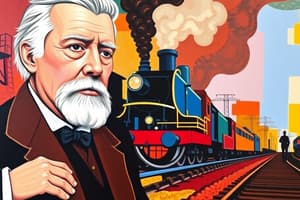Podcast
Questions and Answers
How did the expansion of railroads impact the steel industry?
How did the expansion of railroads impact the steel industry?
- Railroads had little impact on the steel industry.
- Railroads increased the demand for steel, as steel was used to build tracks, bridges, and other railroad infrastructure. (correct)
- Railroads primarily used iron, not steel, for construction, so the steel industry remained unaffected.
- Railroad expansion decreased the demand for steel, as it made other transportation methods obsolete.
What was the main way in which railroads contributed to the rise of the oil industry?
What was the main way in which railroads contributed to the rise of the oil industry?
- Railroads actively promoted the use of kerosene, a byproduct of oil refining, as a primary fuel source.
- Railroads were not related to the oil industry as oil was rarely used in transportation during this period.
- The expansion of railroads fueled a need for lubrication oil for engines and moving parts. (correct)
- Oil was used to power trains, making railroads reliant on the oil industry for fuel.
Which scenario BEST describes the relationship between railroads and the steel industry?
Which scenario BEST describes the relationship between railroads and the steel industry?
- The steel industry benefited from railroads, supplying them with material, but railroads had little impact on the steel industry's overall growth.
- The steel industry was already thriving before the advent of railroads, and railroads had little impact on its progress.
- Railroads and the steel industry were mutually dependent; railroads needed steel for construction, and steel production was boosted by the demand for steel for railroad projects. (correct)
- Railroads relied on steel, but steel production remained largely unaffected by the growth of railroads.
How did railroads facilitate the development of the oil industry?
How did railroads facilitate the development of the oil industry?
Which statement accurately reflects the impact of railroads on the oil industry?
Which statement accurately reflects the impact of railroads on the oil industry?
Flashcards
Impact of Railroads on Steel
Impact of Railroads on Steel
Railroads increased the demand for steel in construction and manufacturing.
Railroads and Oil Industry
Railroads and Oil Industry
Railroads facilitated the transportation of oil, boosting its production and distribution.
Steel Manufacturing Growth
Steel Manufacturing Growth
The demand for railroads led to advancements in steel manufacturing methods.
Economic Boom from Railroads
Economic Boom from Railroads
Signup and view all the flashcards
Industrial Revolution Catalyst
Industrial Revolution Catalyst
Signup and view all the flashcards
Study Notes
Effects of Railroads on Other Industries
-
The expansion of railroads created a massive demand for steel, significantly boosting the steel industry. Railroad tracks required enormous quantities of steel for construction, leading to the development of new steel production methods and larger, more efficient steel mills.
-
This increased demand drove innovation in steel production techniques, leading to the mass production of stronger and cheaper steel. Improvements included the Bessemer process and open-hearth process, enabling significantly higher output and improved steel quality.
-
The rise of railroads stimulated the growth of the oil industry. As railroads expanded, they needed a reliable and efficient lubricant for their machinery. Oil, extracted and refined, emerged as the superior choice.
-
The need for large amounts of crude oil led to the development of oil drilling and refining technologies. This included better drilling rigs, pipelines, and refining techniques to meet the growing demand from railroads and eventually other industries as well.
-
The oil industry's development was intertwined with the railroad's ability to transport raw materials and products across vast distances. Railroads provided the infrastructure necessary for the transportation of crude oil from oil fields to refineries and eventually to consumers.
-
As a result of railroads increasing demands for oil, there were rapid advancements. The demand for oil spurred the exploration of new oil fields, the building of pipelines and refineries, and the development of transportation networks efficiently moving oil.
-
Furthermore, the railroad's extensive network created new markets for oil products. The widespread availability of oil as a lubricant for machines, fuel for lamps, and other applications helped to further expand the oil industry and its economic impact.
-
The construction of railroads fostered the growth of manufacturing industries as well. The need for building materials, locomotives, and other related goods created jobs and drove demand for various manufacturing products. Railways acted as a catalyst for local and regional economies as well.
-
The expansion of railroad lines led to the establishment of new towns and cities along these routes. This growth was supported by developments in supporting industries, such as restaurants, hotels, and other local businesses that provided services to the railroad workers and passengers.
-
The interconnection created by railroads facilitated the movement of goods between distant locations, creating wider markets, and prompting specialization in distinct industrial processes. This led to economies of scale and decreased production costs.
-
Demand for coal for fuel to power locomotives also boosted the coal mining industry, a crucial supporting sector necessary to run the railways. Increased demand led to the development of larger, more efficient coal mines along railroad lines.
Studying That Suits You
Use AI to generate personalized quizzes and flashcards to suit your learning preferences.



